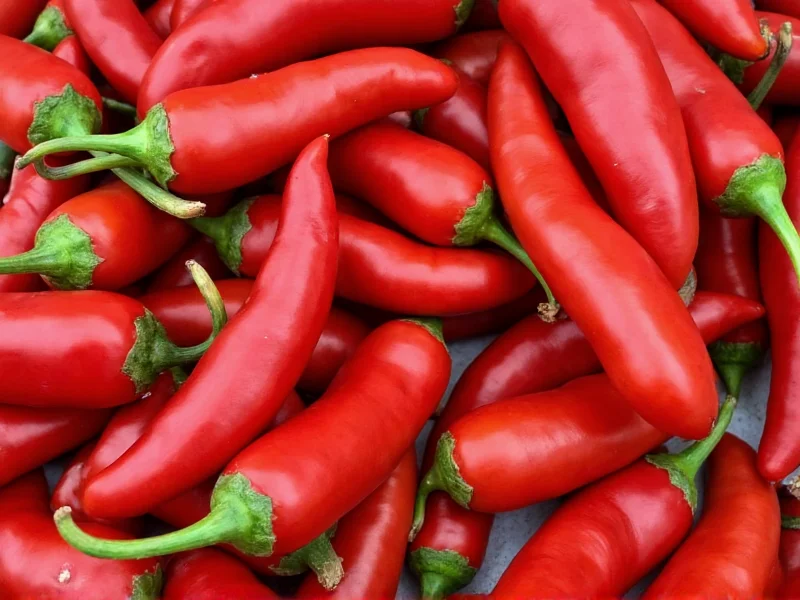Understanding what guajillo peppers are begins with recognizing their distinctive characteristics. These dried chilies measure 3-6 inches long with a smooth, shiny exterior that ranges from mahogany to deep red when dried. Unlike many hot peppers, guajillos offer a complex flavor profile with notes of berries, tea, and subtle tanginess rather than intense heat. Their moderate Scoville rating makes them accessible for most palates while still providing authentic Mexican culinary depth.
Physical Characteristics of Guajillo Peppers
Guajillo peppers transform significantly from their fresh mirasol state to their dried form. When selecting guajillos at the market, look for these identifying features:
| Characteristic | Description |
|---|---|
| Color | Deep reddish-brown to mahogany |
| Length | 3-6 inches (7-15 cm) |
| Shape | Long, tapered with a distinctive curved tail |
| Texture | Smooth, almost leathery exterior |
| Seeds | Flat, round, light-colored seeds that are typically removed before use |
Flavor Profile and Heat Level
When exploring what guajillo peppers are known for culinarily, their balanced flavor stands out. These chilies deliver:
- A bright, slightly fruity tang reminiscent of green tea and berries
- Moderate heat that builds gradually (2,500-5,000 Scoville Heat Units)
- Earthy undertones that deepen when toasted
- A smooth mouthfeel without overwhelming spiciness
Compared to other common dried chilies, guajillos sit between anchos (milder, sweeter) and pasillas (darker, more complex) in both heat and flavor complexity. This makes them incredibly versatile for creating layered sauces without dominating other ingredients.
Culinary Applications of Guajillo Peppers
Professional chefs and home cooks value guajillo peppers for their ability to enhance dishes without overpowering them. Understanding what guajillo peppers are used for reveals their starring roles in:
- Traditional Mexican red sauces and moles
- Adobo marinades for meats and poultry
- Salsas rojas and pipián sauces
- Stews and braises requiring subtle heat
- Infused oils and vinegars
Unlike hotter chilies that primarily contribute heat, guajillos provide both flavor complexity and moderate warmth, making them foundational in authentic Mexican cuisine rather than merely a heat source.
Proper Preparation Techniques
Before using dried guajillo peppers, proper preparation unlocks their full flavor potential. Here's how to prepare them correctly:
- Remove stems and shake out most seeds (keeping some maintains flavor complexity)
- Toast lightly in a dry skillet for 20-30 seconds per side until fragrant
- Soak in hot water for 15-20 minutes until softened
- Blend with other sauce ingredients until smooth
This rehydration process transforms the brittle dried peppers into a pliable ingredient perfect for creating silky-smooth sauces. Never skip the toasting step, as it develops deeper flavor compounds through the Maillard reaction.
Guajillo Pepper Substitutes
When determining what guajillo peppers can be replaced with, consider both flavor and heat profiles. The best substitutes include:
| Substitute | Similarity | Adjustment Needed |
|---|---|---|
| Ancho peppers | 70% similar flavor | Use 25% more for equivalent heat |
| California peppers | 60% similar flavor | Add pinch of cumin for complexity |
| Chipotle in adobo | 40% similar flavor | Use half amount, add sweetness |
| Pasilla peppers | 80% similar flavor | Use equal amount, slightly earthier |
For authentic results when exploring what guajillo peppers bring to a recipe, pasillas offer the closest substitute, though they run slightly darker and earthier. Anchos work well when you need milder heat with similar fruitiness.
Where to Find and Store Guajillo Peppers
Finding quality guajillo peppers requires knowing where to look and how to assess freshness. Specialty Mexican markets typically offer the best selection, though many mainstream grocery stores now carry them in the international or spice aisle. When selecting guajillos, choose peppers that are:
- Flexible rather than brittle (indicates proper moisture content)
- Deep, uniform color without dark spots
- Fragrant with a subtle fruity aroma
Store dried guajillos in an airtight container in a cool, dark place where they'll maintain quality for 6-12 months. For extended storage, keep them in the freezer where they'll remain viable for up to two years without significant flavor degradation.
Common Questions About Guajillo Peppers
Are guajillo peppers the same as California peppers?
No, while both come from the same species (Capsicum annuum), guajillo peppers are dried mirasol chilies with a distinctive tangy flavor, whereas California peppers (also called Anaheim) are typically used fresh or dried with a milder, more vegetal profile. Guajillos run hotter and more complex than California peppers.
Can you eat guajillo peppers whole?
While technically edible, guajillo peppers are almost always rehydrated and blended into sauces rather than eaten whole. Their tough, leathery texture doesn't soften sufficiently for pleasant whole consumption, and removing seeds/stems improves the final texture of prepared dishes.
How do guajillo peppers compare to ancho peppers in heat?
Guajillo peppers (2,500-5,000 SHU) are slightly hotter than ancho peppers (1,000-2,000 SHU). Both fall in the mild to medium heat range, but guajillos deliver a more pronounced warmth with their characteristic tangy flavor, while anchos offer sweeter, raisin-like notes with less noticeable heat.
What dishes showcase guajillo peppers best?
Guajillo peppers shine in Mexican red sauces, particularly salsa roja, mole rojo, and adobo sauces. They're essential in traditional dishes like chile colorado, carne mechada, and pipián rojo. Their balanced heat and complex flavor also work beautifully in marinades for grilled meats and in vegetable stews.
Do guajillo peppers need to be toasted before use?
Yes, toasting guajillo peppers in a dry skillet for 20-30 seconds per side significantly enhances their flavor profile. This process develops deeper, more complex notes through the Maillard reaction and helps release essential oils. Always toast before rehydrating for the most flavorful results in your cooking.











 浙公网安备
33010002000092号
浙公网安备
33010002000092号 浙B2-20120091-4
浙B2-20120091-4